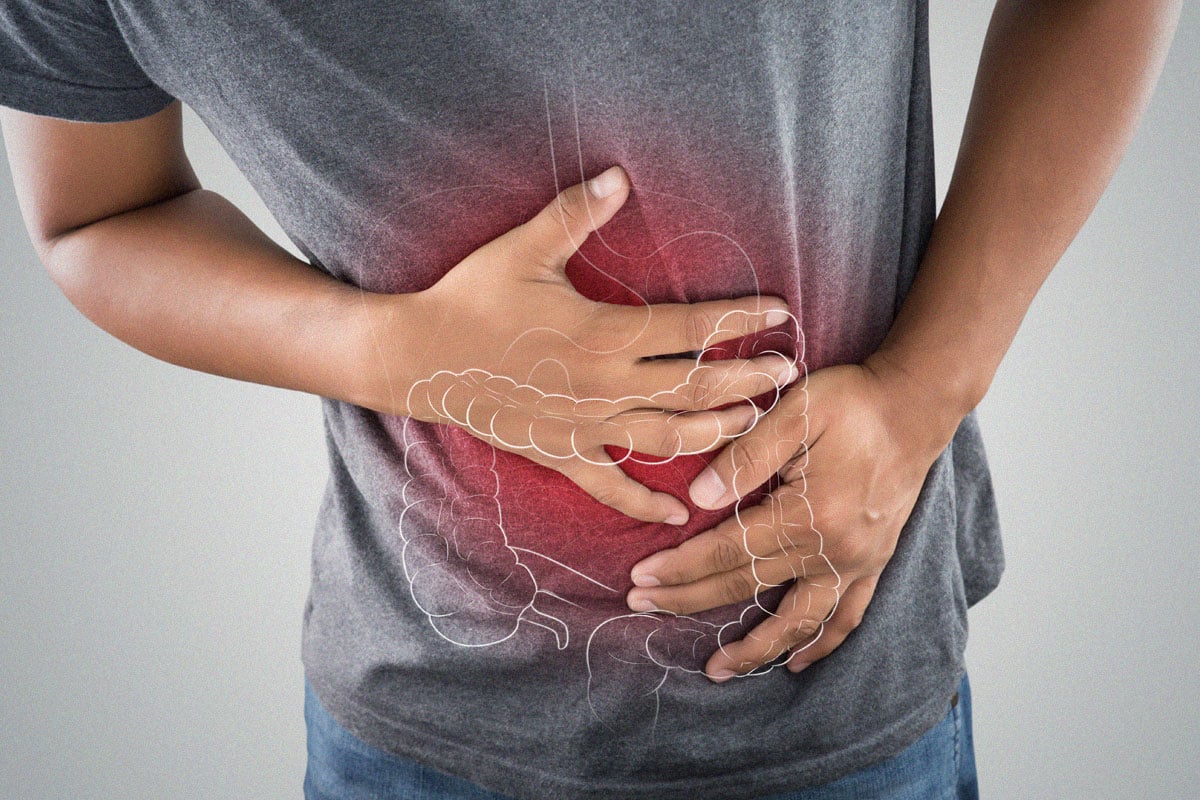Maintaining a stable inner equilibrium requires a varied diet and complete diet. Simply put, that old adage “you are what you eat” is spot on. The simple fact is, our body and mind both depend on a healthy digestive system—and the food we put into our mouth plays a key role in not only easing hunger and fueling our energy needs, but also in keeping specific areas of health in proper working order.
Article at a Glance
The Digestive System
- A system of interrelated organs that breaks down food and helps us absorb nutrients
American Standard Diet
- The American Standard Diet, it includes fried food, red meat, processed foods, etc.
- Research shows that Americans have improved their diets overall, but a lot of work remains
- The American Standard Diet is now affecting other countries
How Poor Diet Affects Health
- There are long-term consequences to a bad diet
- Millions of Americans are considered obese
- Obesity is a precursor to many diseases
Digestive Problems
- Digestive problems can be genetic, stress-related or food borne
- Diarrhea and constipation are two of the most common conditions
- Poor diets are usually to blame for both conditions
- A responsible diet high in recommended amounts of fiber can help
Dietary Fiber
- Two main components: Soluble and insoluble fiber
- Soluble dissolves in water; insoluble is the roughage that moves food through the digestive system
- 25 grams of fiber per day is recommended
The Gut-Brain Axis
- The “gut feeling” phenomenon is real
- Your brain influences your gastrointestinal tract and vice versa
- The gastrointestinal tract has its own nervous system
The Immune System
- The digestive and immune systems are intimately intertwined
- There are more immune cells in your gut than anywhere else in your body
- Human Microbiome Project identified the gastro microorganisms and why they are important
- Keeping your gut bacteria healthy includes fiber, along with prebiotics and probiotics
The Role of the Liver
- Your body needs help absorbing nutrients
- The liver helps cultivate and detoxify nutrients
- A healthy mix of fiber and antioxidants support the liver
But the nutrients we need to survive don’t enter our system through osmosis or some other impossible process. We need to consume foods loaded with these properties, and more than that, we need to properly absorb the elements of our food that add to our overall health. And the only way this is possible is through a healthy digestive system.
A Journey Through Your Digestive System
The digestive system is the processing facility inside of your body that breaks down foods and liquids into their chemical components and eventually into nutrients your body uses for energy or cellular repair. However, the digestive system is more than just your gastrointestinal tract.
Digestion actually begins with your nose. The smell of food tells your mouth to get your saliva ready to break down any incoming sustenance. Then your teeth go to work on the moistened food before it’s all sent down the esophagus to the stomach, where your body’s innate processes take over.
Your stomach, the muscular organ on the left side of the upper abdomen, secretes acid and enzymes that churn your food into a further digestible substance for the small intestine, which absorbs nutrients and sends them into the bloodstream. The remaining food residue moves to the large intestine, where your gut bacteria feeds off the remnants. From there, the waste is disposed of by… well, you know how.
It may all sound very basic, but digestion is actually a complex function that is at the center of good health. And it starts with what we choose to eat.

The Dreaded Standard American Diet
The Standard American Diet is generally defined as all the foods you want to eat every day, but don’t because of how impressively bad it all is for your health. This includes red meat, processed meat like hot dogs, pre-packaged foods, fried foods, high-fat dairy, high-fructose corn syrup, and high-sugar drinks.
Aside from consequences like obesity—an epidemic in America—studies show this poor diet may increase susceptibility to chronic pain, increase pro-inflammatory mediators, and compromise our physiology and behavior in a negative way. While the Standard American Diet has long been implicated in various health challenges in this country, strides have been made since the 1950s to decrease the prevalence of this calorie-dense, high-fat, nutrient-poor diet.
According to data collected by the Pew Research Center in 2016, Americans today eat less beef than they used to and drink far less whole milk. Meanwhile, in general, we care much more about what we eat than in decades past, with 54 percent of Americans saying they pay more attention to eating healthy compared to 20 years ago. That’s the good news. The bad news is our diets include more corn-derived sweeteners, while in general, we eat much more today—an average of 23 percent more calories per day than in 1970.
And it seems our poor eating habits are crossing borders. A 2015 study on adolescents in Lebanon demonstrated that when compared to a traditional Lebanese diet, the Standard American Diet of fast food, red meat, and eggs markedly increased the risk of obesity in youths.
Beyond Weight Gain: How A Poor Diet Affects Health
When we make poor nutritional choices, or when healthy options aren’t available, our body suffers. Most of us have had that bad day when we find ourselves devouring a fast food sandwich for one reason or another, and we all know how it makes us feel afterwards—tired, sluggish, greasy, and generally awful. But beyond that unpleasantness, there are long-term consequences to a chronically bad diet.
The most obvious of these consequences is weight gain. According to the Centers for Disease Control and Prevention (CDC), about 93.3 million American adults are considered obese (an adult standing at 5’9”, weighing more than 200 pounds, with a body mass index of 30 or higher), while the medical costs associated with obesity approaching $148 billion in 2008.
And those medical costs are paying for a plethora of perilous conditions, including high blood pressure, type-2 diabetes, stroke, heart disease, osteoarthritis, and so much more. Even depression has been linked to a poor diet and obesity.
According to the Centers for Disease Control and Prevention (CDC), about 93.3 million American adults are considered obese
When The Digestive System Derails
The machinery of the digestive system doesn’t always run smoothly, with multiple conditions causing all sorts of problems that prevent a healthy mechanical flow. Some of these problems are genetic, while others are stress related, and still others directly linked to the foods we consume. We are all guilty of not always eating what could be considered a healthy diet—whether it’s because our busy lifestyle leaves little time to focus on digestive health or keeping a well-stocked array of fresh fruits and vegetables is just too expensive. Add to that the amount of pesticides used in non-organic farming (not to mention the entire GMO mess), and it’s hard to deny that our guts are under nearly constant assault.
Whatever the reason, the consequences of an unhealthy diet include a motley crew of uncomfortable and possibly dangerous conditions. For starters, there’s diarrhea and constipation, two of the more common digestive issues. Both conditions can have a number of triggers, but poor diet seems to be among the most prevalent causes, especially as we grow older. But age isn’t completely at fault—no matter our age, sugar, fried foods, dairy, spicy food, gluten, and more can spark digestive drama manifested as unformed and watery stool.
And when diarrhea sets in, the risk of dehydration is constant. Losing all those liquids can make a bad situation worse, leaving you weak and vulnerable to a host of problematic medical conditions.
As for constipation, this often demoralizing bathroom situation could have a number of causes as well, but a big culprit is a lack of high-fiber foods in your diet. Eating high-fat meats, dairy, or decadent desserts—while incredibly pleasurable—will not aid in regular bowel movements. Conversely, vegetables, fruits, and whole grains deliver the fibrous punch your body needs to keep the system running in top form. An increase in dietary fiber intake has been shown to increase the frequency of successful visits to the bathroom, while a recent review demonstrated that over 75 percent of chronic constipation sufferers found a measure of relief by increasing dietary fiber.

What Is Dietary Fiber?
Also called roughage, dietary fiber is plant-derived food that cannot be completely broken down by our digestive enzymes. There are two types of necessary dietary fiber: soluble and insoluble. Soluble fiber dissolves in water and is found in oats, peas, beans, apples, citrus fruits, carrots, and more. Meanwhile, insoluble fiber is the roughage that promotes healthy movement through the bowels and includes whole-wheat flour, bran, nuts, and vegetables of every shade and texture.
And besides keeping the digestive train on track, both soluble and insoluble fibers help you feel full longer, keeping you satiated and less likely to snack—making fiber important for maintaining a healthy weight.
But, as we all know, too much of a good thing can quickly become a bad thing, and too much fiber can actually lead to digestive discomfort and even make diarrhea or constipation worse. That’s why it’s important to stay within the recommended daily intake of dietary fiber. According to the American Heart Association, the daily value for fiber is 25 grams per day based on a 2,000-calorie daily diet. However, reflecting the growing emphasis by health experts on the importance of dietary fiber, the recommended daily intake of fiber on food and supplement labels was recently increased to 28 grams, showing that the rewards are much greater than the risks.
As for what 25 grams of fiber actually looks like, that’s about five large apples or five cups of broccoli or eight bananas or about 11 cups of chopped cauliflower. That’s a lot of fruit and veggies to go through every day!
The Gut-Brain Axis & Overall Health
The well-used phrase “gut feeling” generally relates to intuition or instinct—like when you sense bad news on the horizon, you characterize it as a gut feeling that something is wrong. But what if your gut was more than merely an abstract way to describe how you feel? What if your gut was tied to your brain's health in a physiological way?
That’s right—those butterflies in your stomach, they’re real. The gut-brain axis refers to the influence your brain has on your gastrointestinal tract, and vice versa, as your stomach and brain communicate with each other via a digestive-tract superhighway of microorganisms in an effort to achieve bodily homeostasis. And that connection has proven to have an influence on health, as studies have demonstrated that certain brain-related conditions, like anxiety and depression, display an altered gut microbiota.
Some experiments have even shown that changing microbiota can influence the brain. One study demonstrated that a diet heavy with certain types of probiotics altered the brain regions that control emotion and sensation. Another study showed that individuals who consume probiotics displayed a decrease in psychological stress.
Indeed, your gastrointestinal tract has its own nervous system, called the Enteric Nervous System (ENS). This is the system that keeps your intestines in working order, moving food through the digestive process. Evidence suggests that microbiota can impact the impulse-transmitting cells of the ENS in different ways. One animal study in particular demonstrated that microbiota are necessary for the firing of normal gut sensory neurons, providing a potential mechanism for the transfer of information between the microbiota and nervous system.
How The Immune System Works With Our Digestive System
While maintaining its own homeostasis, the gastrointestinal system also plays a central role in our immune system’s role of protecting against allergens. After all, the major components of our digestive system come into intimate contact every day with the external environment—including beneficial foods, as well as potentially dangerous pathogens.
And, of course, while we all know that bacteria lives in our gut, do you know exactly how much bacteria our gut harbors? For a long time, it was “common knowledge” that bacteria and other microbes outnumber our own human cells by a ratio of at least 10:1, but more recent studies have revisited that claim, netting results that bring the numbers much closer together. The new study demonstrates that we house an average of approximately 30 trillion human cells and 39 trillion bacteria, much closer to a one-to-one ratio that previously reported.
In an effort to map the genetic sequence of trillions of microbes in your gut and examine the correlation between gut bacteria and overall health, the National Institute of Health (NIH) launched the five-year Human Microbiome Project in 2007. The far-reaching project had researchers sample 242 healthy volunteers (129 male, 113 female), collecting tissues from 15 body sites in men and 18 in women. In order to illustrate the diversity across our microbiome, researchers said that “each body site can be inhabited by organisms as different as those in the Amazon Rainforest and the Sahara Desert.”
The results of the project identified that more than 10,000 microbial species occupy the human ecosystem, with researchers calculating that they have identified between 81 and 99 percent of all microorganismal genera in healthy adults.
"We have defined the boundaries of normal microbial variation in humans," said James M. Anderson, M.D., PhD, director of the National Institute of Health (NIH) Division of Program Coordination, Planning and Strategic Initiatives. "We now have a very good idea of what is normal for a healthy western population and are beginning to learn how changes in the microbiome correlate with physiology and disease."
How Your Liver Relates To Digestive Health
The nutrients that result from your gastrointestinal system’s processes don’t get absorbed into your body without help from your liver, which works to cultivate and detoxify those helpful nutrients. Among its main functions, your liver is tasked with metabolizing carbohydrates, proteins, fats, and minerals. It accomplishes this by producing bile, a substance that breaks down fats and assists in digestion.
In order to stay healthy and do its job as a vital cog in digestion, your liver needs organic liver support. According to the American Liver Foundation, a healthy mix of grains, fruits, veggies, and protein all contribute to a liver functioning at peak performance. Additionally, a healthy dose of fiber also plays a role in supporting your liver.
Many dark berries, like cranberries, blueberries, and raspberries, contain lots of antioxidants called polyphenols, which may help protect your liver from damage by reducing inflammation and helping to rid the system of free radicals. Then there’s milk thistle, a lesser-known plant with the potential to help the liver fight some of its most dangerous foes, which is used in therapeutic applications by people who manage liver conditions.
According to the American Liver Foundation, a healthy mix of grains, fruits, veggies, and protein all contribute to a liver functioning at peak performance.
How Prebiotics & Probiotics Influence Health
Making sure that your millions of gut bacteria remain healthy is much like maintaining overall digestive health. It involves filling up on fiber, limiting fats, and practicing an overall healthy lifestyle with exercise, plenty of sleep, and stress abatement. You also want to make sure you are incorporating prebiotics (food for healthy bacteria) and probiotics (actual live “good” bacteria) into your diet.
Probiotics foods include yogurt, kimchi, miso, and sauerkraut, while prebiotics include whole grains, greens, bananas, garlic, and fiber (such as from psyllium). Aside from showing promise in helping people deal with irritable bowel syndrome, a 2017 review of probiotics suggests that they may help to alleviate the symptoms of depression. So, it’s important for both your body and your mind to get probiotics into your guts—and to keep them fed with prebiotic fiber—for the greatest positive impact on your personal microbiome.
Holistic Dietary Health
Food is enjoyment, food is life. Make sure your digestive system has the tools it needs to join you in that celebration. From general stomach and digestive tract health, all the way up to your brain and mental state, it’s all connected. Feed your system what it needs to stay on track!









